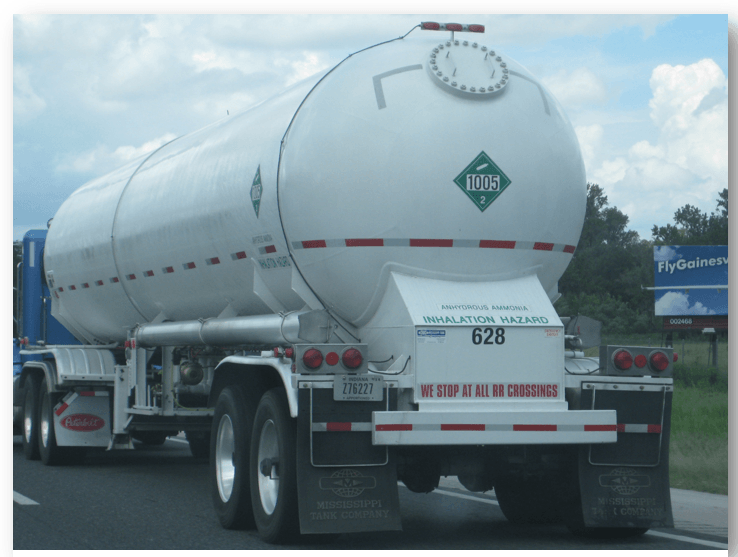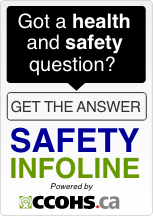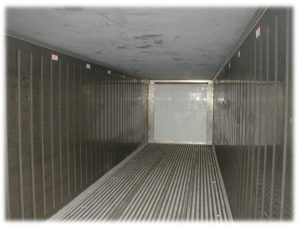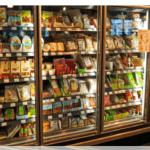The Transportation of Dangerous Goods (TDG) Act was created after the November 10, 1979 train derailment in Mississauga Ontario. It lead to a large explosion due to leaks in propane, caustic soda, polystyrene, fiberglass insulation, and chlorine.
A trained TDG worker must have sound knowledge of all the topics that relate to the handling and transportation of dangerous goods. Errors caused by untrained personnel in packaging, documentation, or labeling requirements could result in injury or death.
What are Dangerous Goods?
Dangerous goods are referred to as hazardous materials in jurisdictions such as the United States. DG are products that present a risk to health, safety, and property. You can find the legal definition of dangerous goods in the Interpretation section of the TDG act. The legal definition of dangerous goods is:
“dangerous goods mean a product, substance or organism included by its nature or by the regulations in any of the classes listed in the schedule to the Act.”
The purpose of the classification of dangerous goods is to understand potential risks of transporting those goods and how to move them safely.
What is the classification of dangerous goods?
Classification of dangerous goods means grouping them into classes with standard descriptions that include:
- UN numbers
- Names
- Descriptions
- Packaging requirements
- Transport restrictions.
How Many Classes of Dangerous Goods are there?
 There are 9 classes of dangerous goods. Some classes are further separated into divisions. The 9 classes in their chronological order are explosives, gases, flammable liquids, flammable solids, oxidizing substances, toxic & infectious substances, radioactive material, corrosives, misc dangerous goods.. Dangerous goods are classified through consultation and tests with someone who understands the nature of the dangerous good such as manufacturers, scientists, or lab technologist.
There are 9 classes of dangerous goods. Some classes are further separated into divisions. The 9 classes in their chronological order are explosives, gases, flammable liquids, flammable solids, oxidizing substances, toxic & infectious substances, radioactive material, corrosives, misc dangerous goods.. Dangerous goods are classified through consultation and tests with someone who understands the nature of the dangerous good such as manufacturers, scientists, or lab technologist.
Class 1 Explosives
1.1 Mass Explosion Hazard
This is a material what will affect the entire load without any delay. Examples of class 1.1 explosives are demolition charges and detonating cords.
1.2 Fragment Projection Hazard
Pieces of this material will fly off at dangerous speeds during an explosion. For example, fireworks or flares.
1.3 Fire Hazard
These materials will cause a fire to start. For example, aerial flares and propelling charges.
1.4 No Significant hazard Beyond Package
This material does not present large explosive damage beyond its package. Examples of class 1.4 explosives are air bag inflators and practice ammunition.
1.5 Very Insensitive with a Mass Explosion Hazard
This material includes material with a mass explosion hazard such as blasting explosives.
1.6 Extremely insensitive with no Mass Explosion Hazard.
Class 2: Gases
 2.1 Flammable Gases are gases that may be flammable and even corrosive or toxic. Vapours will move to a source of ignition and flash back. For example, class 2.1 flammable gases include propane and flammable aerosols.
2.1 Flammable Gases are gases that may be flammable and even corrosive or toxic. Vapours will move to a source of ignition and flash back. For example, class 2.1 flammable gases include propane and flammable aerosols.
2.2 Non-flammable gases are gases that do not burn readily but may support a fire. They may also be corrosive or cause suffocation by limiting oxygen supply. Non-flammable aerosols and fire extinguishers with compressed gas are examples of class 2.2 gases.
2.2 (5.1) Examples of class 2.2 (5.1) oxygen and oxidizing gases are compressed air and carbon dioxide. These oxidizing gases contribute to the combustion of other materials.
2.3 Toxic Gases
Class 2.3 Toxic Gas is extremely poisonous. They can be flammable and corrosive. Small amounts of toxic gases can present large health risks especially if inhaled or absorbed. Examples of class 2.3 toxic gases include chlorine and ammonia products.
Class 3 Flammable Liquids
Flammable Liquids are liquids that give off vapours which will move towards a source of ignition and flash back. Some vapours can be poisonous and may be toxic or corrosive. Examples of flammable liquids include petroleum ether, and ethyl chloride. Combustible liquids are liquids that require more effort to ignite and require heat or spark flames to reach their flash point. For example, alcoholic beverages with more than 70% volume are class 3 flammable liquids – combustible liquids.
Class 4 Flammable Solids
These substances are solids that are liable to spontaneous combustion. That can also emit flammable gases if they encounter water.
Class 4.1 Flammable solids
Flammable solids are easily ignited and usually do so with friction. An example of flammable solid includes coated aluminum powder.
Class 4.2 Substances prone to spontaneous combustion
Certain substances such as wet cotton can ignite if they encounter air.
Class 4.3 Water reactive substances
Water reactive substances are solid flammable goods that can ignite upon contact with water or moist air. For example, aluminum carbide and lithium batteries.
Class 5 Oxidizing substances and organic peroxides
Class 5.1 Oxidizing substances
These substances will grow a fire and may explode from heat or contamination. For example, sodium peroxide.
Class 5.2 Includes goods that will burn quick and ignite wood, oil, fuel, paper, or other organic materials that can cause an explosion. There is no vapour hazard unless a fire is involved. Example of class 5.2 organic peroxides include body fillers such as dibenzoyl peroxide.
Class 6 Toxic Substances
Class 6.1 toxic materials that are toxic substances can be poisonous liquids or solids. They can be fatal if they are inhaled, absorbed or swallowed. Examples include, calcium cyanide and arsenic.
6.2 Infectious Substances
These are goods that contain micro-organisms that can be infectious to humans and animals. For example, disinfectants and germicides are infectious substances.
Class 7 Radioactive Materials
Substances are radioactive materials within the meaning of the Nuclear Safety and Control Act. These packages produce harmful radiation and damaged packages should not be handled or transported. Examples of class 7 radioactive materials include nuclear fuel roads.
Class 8 Corrosives
Corrosives are substances that corrode and because severe injury burns and deterioration of outer skin through internal tissues. Examples of corrosives include sulfuric acid and sodium hydroxide.
Class 9 Miscellaneous Products Substances or Organisms
These are substances that do not meet the criteria for classes 1 to 8. Examples include dry cell batteries and materials used in brake shoes.
Who is responsible to classify a dangerous good?
The shipper is the party responsible to group a dangerous good into its correct classification rating. The carrier is responsible for reporting any errors in the classification made by the shipper.
What Information Does TDG Schedule 1 Contain?
Schedule 1 contains information on the transportation of dangerous goods listed by UN number. When you know a good’s UN number you can find information on it including the shipping name, class, packing group, special provisions, explosive limit and limited quantity index, excepted quantities, ERAP index, and passenger carrying road vehicle index.
If a number is shown under column 7, ERAP index, of schedule 1, what does this number represent?
The ERAP number is the total number of quantity that can be transported until an emergency response assistance plan is required. The number means kilograms for solids, liters for liquids, and capacity in liters of the means of containment for gases.
What does it mean if the ‘ERAP index’ for a product is blank?
If the ERAP index is blank an emergency response assistance plan is not required for the product regardless of the quantity transported. ERAP stands for emergency response assistance response plan.
What is a UN number on an MSDS?
A UN number is the United Nations 4-digit number used to identify a dangerous good. It is listed in column 1 of schedule 1.
The ‘limited quantity index’ for a product is 0?
If a good is transported in small quantities, it is exempt from many of the TDG regulations. If the limited quantity index is 0 you would be exempt from the regulations only if you transport 0 quantity of the good. If there is a number greater than 0 then you can transport that good for up to that quantity amount before the TDG regulations would apply. Excepted quantities are quantities of a dangerous good that can be transported in small quantities that can be marked with an Excepted Quantities Mark are do not need to adhere to transport regulations.
TDG Forbidden Goods
TDG forbidden goods are listed in column 4 of schedule 1 of the regulations and mean the goods must not be transported.
What is a special provision TDG
Column 5 of schedule 1 lists the special provisions. The number reference to specific instructions listed in schedule 2. Special provisions may include information for labeling requirements, and quantity limits that don’t apply for certain UN numbers.
An approved erap is required before transporting UN1105.
Schedule 3 give the shipping names of dangerous goods in alphabetical order it is the schedule to use if the UN number is not available.
Shipping Document
Who is responsible for completing the shipping document?
The shipper is responsible for completing the shipping document and giving it to the carrier.
A TDG shipping document template should include the shipper or consignor’s information, date the shipping document was prepared, accurate description of the dangerous goods, emergency information, ERAP information, and shipper’s certification.
Standard description of dangerous goods
The description of a dangerous good should include the following information in the same order listed:
- UN Number
- Shipping Name
- Primary and Subsidiary Class
- Packing Group
- Toxic by Inhalation
- Total Quantity
- Packages Requiring Labels.
The residue last contained means less than 10 percent of its maximum fill limit is contained within the means of containment.
How placards should be placed on a large means of containment?
Placards for a large means of containment should be a diamond shaped dangerous goods label and placed square on a point. They must be at-least 250mm long on each side. They need to be on each end and on each side of the large means of containment. A large means of containment refers to the trailer such as tanker or container. The display of UN number may be required and if they are, they must be in black letters. Remember these dimensions when buying placards in Canada.
A small container holds 450 liters.
TDG Training Certificate
A training certificate is required for any person who handles, offers for transport, or transports dangerous goods. If an inspector asks to see proof of TDG training, the person must produce it immediately.
Training certificates are valid for 3 years from the date of issuance. TDG trained personnel must keep the training certificate on them when handling or transporting dangerous goods. Employers must keep records of TDG training up to 24 months after the certificate expires. In case an employee happens to change jobs before a TDG certification expires, they must be retrained by their new employer.
Penalties for TDG violations
Penalties for non-compliance with TDG regulations can be up to $50,000 for the first offense and up to $100,000 for further offenses. In certain circumstances, prison time can be imposed. What drivers need to transport hazardous material is a valid training certificate on them.




The federal TDG Regulations apply to everyone. The regulations even apply when a member of the public transports dangerous goods such as gasoline, oxygen, and propane for personal use. However, certain exemptions exist for small quantities or for specific situations.